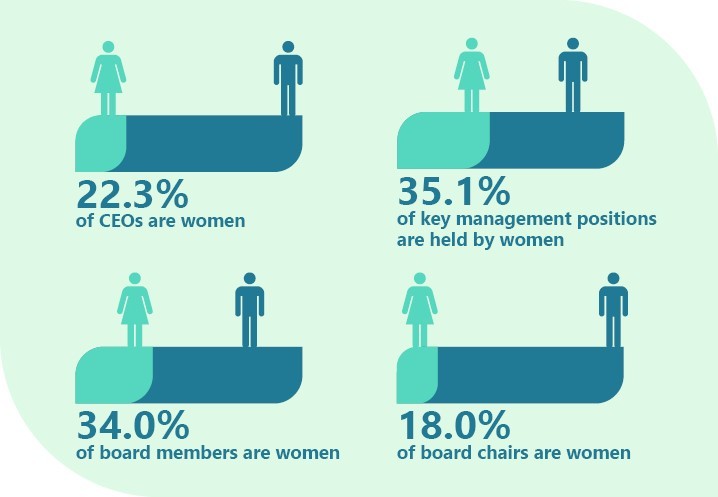Men are typically over represented in management and leadership roles across most industries. This is particularly the case in mining, construction, utilities and manufacturing.[31] Even in female‑dominated industries, men are still more likely to occupy more senior positions.

Women remain under-represented in all key decision-making roles across almost all industries in the Australian workforce comprising only: 22.3 per cent of CEOs, 35.1 per cent of key management positions, 34 per cent of board members, and 18 per cent of board chairs.[32]
The prevalence of technology facilitated gender based violence can also seriously impact professional lives (eSafety, 2022). The disrespect and abuse women experience online can be a barrier to using digital spaces to promote business interests or hold visible leadership positions.
- The Australian Public Service (APS) has demonstrated that targeted gender equality strategies are an effective way to promote more women into senior leadership positions, with the proportion of women in senior executive roles in the APS increasing from 26.8 per cent in 2001 to 52 per cent in 2022.
- The Government is also working to improve women’s representation on Government boards and advisory bodies, through setting measurable gender balance targets and bi-annual reporting on these targets.
- At June 2022, women held 51.4 per cent of Australian Government Board positions, up from 33.4 per cent in 2009 when targets were first introduced.[33] Building from this success, there is a need to now focus on boosting representation on boards in those areas of the Government that are highly segregated, and increasing the number of women in Chair and Deputy Chair leadership positions.
- In the 47th Australian Parliament, women hold 44.4 per cent of seats across both chambers. This is made up by 38.4 per cent of seats in the House of Representatives, and 56.6 per cent in the Senate. This includes 10 women in Cabinet (43.5 per cent), which is the largest number of women to ever hold positions in an Australian Cabinet.
- Women account for 41.9 per cent of overall positions in State and Territory Parliaments in Australia.[34] Six of the eight State and Territory Parliaments are gender balanced, with women and men each holding at least 40 per cent of positions. These are the Australian Capital Territory Legislative Assembly, the Northern Territory Legislative Assembly, the Parliament of Western Australia, the Parliament of South Australia, the Parliament of Victoria and the Parliament of Tasmania.
Prompt
What do you think are the main challenges to achieving gender equal leadership and representation?
[31] WGEA (Workplace Gender Equality Agency) (2022) Australia’s gender equality scorecard 2021-22, Sydney, December 2022.
[32] Ibid.
[33] Office for Women (2022) Gender Balance on Australian Government Boards report 2021-22
[34] APH, (2023) Gender composition of Australian parliaments by party: a quick guide
